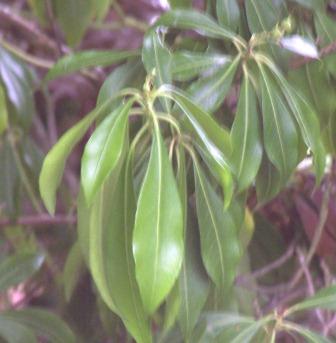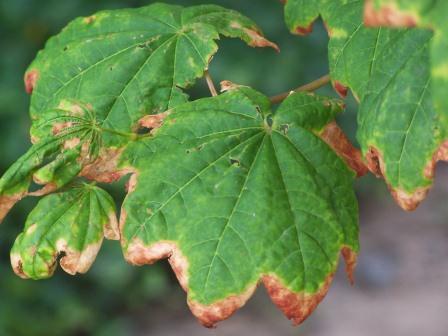Today I was sent a link to a posting on “droopy leaves.” Essentially, it suggests that droopy leaves are a means to conserve water on hot days and that watering these plants causes more problems than it solves because the roots don’t get enough oxygen. A link to the science of transpiration is provided. The advice is to wait until the evening and if the plants perk back up, then they didn’t need water after all.
This is one of those maddening articles that has enough science in it to make it sound reasonable, but is ultimately incorrect in its assumptions and advice. It’s worth looking at the topic in a little more detail.
Some plants are adept at conserving water in hot weather. Their leaves tend to be small, thick, with a heavy layer of waxes protecting the surface. Leaves can also move to limit their sun exposure and thus reduce the heat load. But wilting is not a method of conserving water. Instead, it’s a sign that water loss (evapotranspiration through the leaves) exceeds water uptake from the roots. And if you ignore wilt, you do so at your own peril. Once terminal wilt is reached, it’s all over for that part of the plant.

Wilt. Sorry it’s a fuzzy photo.
Large, thin leaves, common in many of ornamental, annual and vegetable species, do not conserve water. Tomatoes, zucchini and black-eyed susans, the plants specifically mentioned in this article, are not water conservers. Chronic wilting of these and other can eventually cause leaf tip and margin necrosis (or tissue death). It also reduces growth, so that your yield of tomatoes, zucchini and black-eyed susans will be decreased.
 Leaf tip and marginal necrosis from chronic drought stress
Leaf tip and marginal necrosis from chronic drought stress
So yes, do water your plants if they are wilting in the midday heat! Use mulches to conserve water! (You’ll notice in the photograph on the linked site that the plants are in bare soil.) Fine root systems are generally near the soil surface, and keeping these hydrated keeps them alive. You won’t see an instantaneous response to watering if plants are already wilting, but they will recover – much better than if you don’t water them at all.
Once again, everything we “know” is wrong!
After growing veggies in a large garden without the benefit of irrigation for most of my life, in recent years I have a much smaller garden with access to water. What a difference it has made! Now I watch the plants at mid-day for the earliest signs of wilting and water accordingly. The results have been much healthier plants, much less disease, and much better production. Anecdotal evidence, yes, but it works for me. Since plants have such a high water content, it stands to reason they don’t do as well when deprived of soil moisture.
I’m guessing we still need to water the base and not get the leaves wet at that time? Or would the moisture to the leaves, immediately, offset the sundrop magnification harm?
A little bit of science can tricky when not fully analyzed. Thanks.
There is no such thing as “sundrop magnification harm”.
I wouldn’t automatically water or not water without checking the soil. Drooping leaves can also mean root rot.
@LJ, @ plantsman is correct that the sun magnfication issue is a myth (if you search this blog you can find my post on the topic from a year or so ago). @Deirdre, you’re right that wilt can be caused by other factors such as root rot, but this isn’t a wilt that goes away once the sun goes down. Wilt during hot weather is generally from evapotranspiration > root water uptake.
On very hot days certain plants wilt regardless of moisture in soil. I think gardeners should use their hands and learn to sense optimum moisture content of their soil. Using your hands, eyes, nose AND head makes it all much more satisfying and will enhance your overall competence.
Found this advice:Drinks For The Droopy?
It’s not uncommon to venture out to the garden at the end of a hot day to find some pretty droopy plants. Don’t immediately assume that they need to be watered. It may be that there is adequate moisture in the soil but your plant’s roots just can’t keep up with the needs of the leaves. If the soil is already moist you are better off letting the plants catch up on their own overnight. If they’re still droopy in the morning give them a drink.
So, how do you estimate moisture from using your finger?Thanks
Under normal conditions, plants only grow as many leaves as their roots can supply with adequate moisture. Plants whose evaporative losses routinely exceed their root uptake in a well-watered soil are probably(1) planted in too hot a location, (2) planted too close to other plants and losing in that competition,(3) planted improperly, or (4) have poor root establishment.
While some gardeners are adept at estimating soil moisture by hand, an inexpensive soil moisture probe might be useful for others (but is not always accurate).
April, regarding the “Drinks for the Droopy” post – my rationale is that if a plant is wilting on a hot day and there’s no standing water over the root zone, then water them when they wilt. If you were thirsty you wouldn’t wait until the next morning to take a drink, right? The danger of assuming that the soil is already moist enough is that it might not be in places where the fine roots actually are.